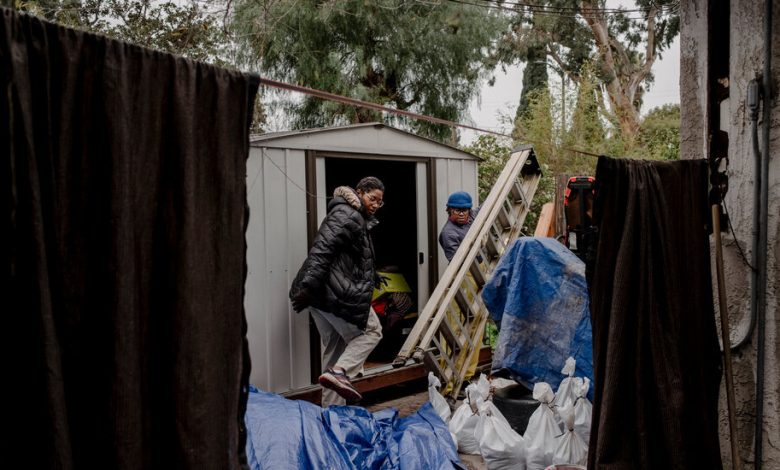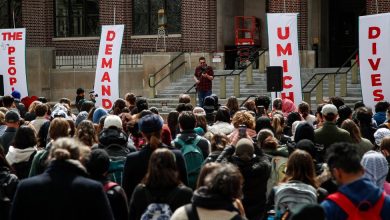Los Angeles County’s Black Residents Are Most at Risk in Major Floods

LONG BEACH, Calif.— When it rains in Queen Hollins’s West Long Beach neighborhood, bordering a freeway with the Los Angeles River just beyond, the storm drains overflow, filling the sides of each street with several inches of water.
Then the sun comes out, the water recedes, and the neighbors go back to worrying about all of the obvious environmental hazards of living in a Southern California neighborhood bordered by three freeways and the Port of Long Beach: heat, drought, air quality and aging infrastructure.
Yet another, invisible hazard may lurk in Ms. Hollins’s neighborhood as well: the threat of severe flooding.
More than 400,000 people live in parts of Los Angeles County that could be inundated with a foot or more of floodwater in a 100-year-flood event, the kind that has a 1 percent chance of occurring in any year, according to a recent study by researchers at University of California, Irvine. And a disproportionate share of the most vulnerable residents are Black.
The analysis found that Black residents of the county were 79 percent more likely than white residents to be living at risk of deep flooding of at least three feet, or about waist high. For Latinos, the figure was 17 percent, and for Asians, 11 percent.
The results of the study, published late last year, raised the stakes for what it means to live in a region buffeted by increasingly severe weather and the challenge of equitably protecting people and property. It also presents challenges for a region more accustomed to responding to the effects of severe rain and flash floods in canyons, hills and coastal beach towns, and not so much in the concrete sprawl and congested urban neighborhoods bisected by the Los Angeles River, which is usually a dry concrete channel baking in the Southern California sun.
And while the threats posed by California’s multiyear drought are far more present than those of a once-a-century flood, the destructive rainstorms that have churned through California over the last three weeks have brought the issue of flooding into dramatic focus. The series of storms, known as atmospheric rivers, swelled many rivers and creeks in the state, flooded fields and highways, caused mudslides, prompted evacuation orders for tens of thousands of people and, as of Tuesday, had caused at least 20 deaths.
“People aren’t thinking about flooding, because it barely rains here in Los Angeles,” Ms. Hollins said, even though, if you look, the threat of flooding was “already a reality.”
Rain and Floods in California
A string of major storms in California has caused extreme flooding and damage across the state.
- Flood Risk: Southern California has escaped the worst of recent rainstorms, but a new study shows that severe flooding could disproportionately affect Black residents.
- Homeless Populations: Most homeless people in California live on the streets, in cars and along rivers. They experienced the long stretch of fierce storms in a way few others did.
- Drought: All the rain and snow are undoubtedly good news for California’s water supply, but they’re unlikely to end the drought altogether.
- Resilient Forests: Though some may be toppled in storms, California’s iconic redwood trees are adapted to a wide range of weather events.
Published in the journal Nature Sustainability, the study by the U.C. Irvine researchers showed that a catastrophic flood event would inundate a number of pockets of Los Angeles County. Among the areas most at risk are a dense tangle of city neighborhoods intertwined with industrial zones, stretching south of downtown Los Angeles. Many of the neighborhoods are clustered around the Los Angeles River, which was excavated and paved decades ago to help prevent flooding.
The study’s high-resolution models showed that between 197,000 and 874,000 people, and between $36 billion and $108 billion in property, lay within the 100-year flood zone and could be exposed to at least a foot of water in such a flood. The impact would be comparable to those of major hurricanes like Katrina, Sandy or Harvey.
In the worst-case scenarios for Los Angeles County, too much water might swamp an aging drainage system and the network of waterways — including portions of the Los Angeles River, Dominguez Channel, Compton Creek and San Gabriel River — that run across the county.
The projected risks of deep flooding “are primarily linked to overtopping of flood channels mostly constructed in the decades following World War II and are now undersized or inadequately maintained,” the study says. The channels’ capacity has been reduced over time by sediment and vegetation, while the volume of runoff they must handle has grown with the “expansion of impervious surfaces” caused by development.
The study cited several cities in particular that demonstrate the outsized impact that floods would have on Black communities. In Long Beach, for example, the exposed population of 88,000 to 262,000 residents is disproportionately non-Hispanic Black, and the situation is similar in the smaller cities of Paramount, Carson and South Gate, some of which have low-lying neighborhoods and businesses in what were once marshlands.
Brett F. Sanders, lead author of the report and a professor of civil and environmental engineering at U.C. Irvine, noted that Black residents make up only around nine percent of the total population of Los Angeles County, “yet that smaller fraction disproportionately settled in a part of the county that would be highly exposed to river flood risk.”
Whose homes would be flooded is only part of the problem. Inequities, the study noted, “are critically important because recovery from floods is often prolonged and incomplete among socially marginalized, low-wealth and vulnerable communities.”
Mr. Sanders said he hoped local officials would use the study when making plans for flood protection. Some ideas to better prepare for major flooding include revisiting building codes, considering elevating the foundations of houses and creating more green space to absorb water.
Focus groups, which included Los Angeles County public works representatives, were used to help develop the study. Another of the study’s authors, Nícola Ulibarrí, an associate professor of urban planning and public policy at Irvine, noted that members of the focus groups said the study’s maps could be used on a micro level for practical action like building bus stops in places residents could reach without walking through flooded streets.
Dr. Sanders said the county and the researchers are in early discussions about how to use the data presented in the study.
Last year, Los Angeles County began reviewing its own policies to get a fuller picture of inequities in infrastructure investments. The examination is independent of the university study.
“We took a historical look at some of our investments in the different sectors, including flood control and water conservation,” said Mark Pestrella, executive director of Los Angeles County Public Works. “Infrastructure can be very reflective of where there was racism and a lack of equity in decision making through the years. So we need to ask why some neighborhoods are fully drained and others aren’t; why some neighborhoods have trees and some don’t.”
Early results from the county examination, he said, showed a nexus between race and ethnicity, and infrastructure investment or the lack of it. “It’s an unfortunate truth,” he said.
Mr. Pestrella said county workers had gone door to door in neighborhoods to raise awareness of the risks of flooding, educate residents about flood insurance and offer tips for retrofitting homes. Los Angeles city officials have said the city had held public workshops on flood risks and was working to update its flood hazard maps.
Los Angeles County Supervisor Janice Hahn, whose district includes some of the impacted areas in the study, said she has asked the Department of Public Works to assess storm water infrastructure and report back to the board with a plan for any necessary changes.
“The report out of U.C. Irvine is alarming,” Ms. Hahn said. “Now the county needs to take a hard look at our infrastructure and see what we can do to protect these communities if and when the storm we are all worried about comes.”
The recent rainstorms have had the most severe impact in the northern and central parts of the state, but they are also awakening more Southern Californians to the risks of flooding in their neighborhoods.
Two years ago, when Jai Phillips, a social worker, purchased his house in Longwood, a narrow sliver of a neighborhood sandwiched between the Los Angeles River and Compton Creek, he had no idea that the area was particularly susceptible to flooding, as the U.C. Irvine study found.
“Every time it rains, there’s a little pool,” said Mr. Phillips, 42. “The size of the pool just depends on how big or how much rain it gets.” It’s so well known an issue, he added, that city workers have to be sent out to spray the pools for mosquitoes.
In the past several weeks, the hard rainfall has caught his attention.
“I keep looking out the front door and I’m like, oh, water is getting higher and higher,” he said. “This is the highest I’ve seen it here, because it’s the most rain we’ve had since I’ve been here, but looking out my window and looking at my neighbor directly across the street, their driveway is starting to get flooded.”
He loves his neighborhood, with its midcentury single-family houses and its magnolia trees. Besides, the “likelihood of a flood is slim, because we’re usually in a drought in California,” he said. “And the L.A. River helps to channel a lot of the water away. And then, again, it’s about, you know, what I could afford. I guess it was like a calculated risk.”
Cathy Castro, a 78-year-old retired language teacher, lives in the Mertz Del Amo Estates mobile home park, near the western bank of Compton Creek. During the rainstorms that blanketed California this month, the streets of her low-lying community “looked like rivers,” she said.
Even so, she said, most of her neighbors in the 500-unit park were more concerned about leaking roofs than the threat of flooding. As for Ms. Castro herself, she was keeping a close eye on the puddles growing ever deeper in the brick planters outside her home. If they overflowed, the water could seep down and damage her foundation.
In West Long Beach, Ms. Hollins has lived and worked for the past 30 years out of her one-story ranch house, set on a property lush with trees, native plants and shrubbery.
Despite the proximity of the river and how quickly a rainstorm can overwhelm the neighborhood’s storm drains, Ms. Hollins and her partner, Yardenna Aaron, did not realize the extent of the flood risk in the area. But they believe extreme weather is only going to worsen.
Ms. Aaron and Ms. Hollins picked up about eight sandbags from the Long Beach Fire Department last week and planned to return for more, Ms. Aaron said. Over the long, rainy holiday weekend, they arranged the sandbags around their garage and supply shed.
This year, they have “needed more tarps, more sandbags, and we had a handyman come out to fortify the shed ahead of time,” she said. “We’re learning.”
On Monday, buckets and jugs they had laid out on their porch to catch rainfall had filled up overnight. But the streets were clear of water, and the sun was out and shining.
Mark Abramson contributed reporting.




